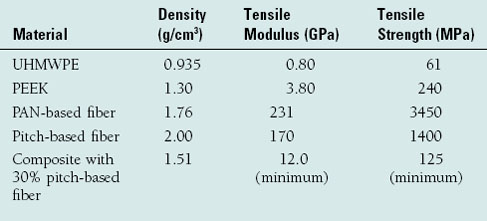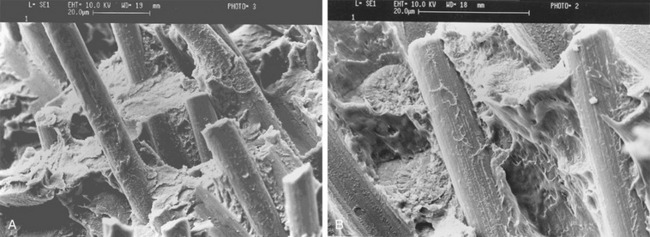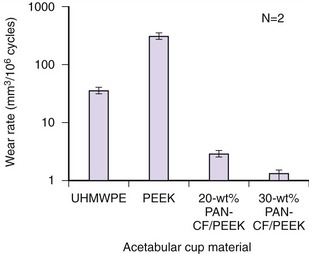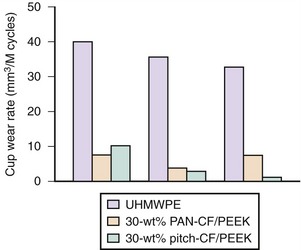CHAPTER 64 New Developments in Alternative Hip Bearing Surfaces
CARBON FIBER POLYMERIC COMPOSITES
Carbon fiber ultra-high–molecular weight polyethylene (UHMWPE) composites were introduced in the early 1980s as tibial bearings (Poly-2; Zimmer, Warsaw, IN). However, the clinical performance was poor with many revisions. Figure 64-1A shows a fracture surface of carbon fiber–reinforced UHMWPE typical of a Poly-2 bearing. There is no interface bonding between the carbon fibers and the polyethylene matrix, as evidenced by the clean fibers. Load can be transferred only by compressive forces between the fibers and matrix, resulting in an inefficient reinforcement.
Carbon fiber–reinforced epoxy composites (CFRP) were introduced in Europe in the late 1980s as acetabular components with alumina femoral heads. The findings have been described elsewhere.1,2 Simulator studies reported a wear rate of 1 to 3 µm per million cycles. Canine hips with CFRP cups were implanted in six dogs for up to 5.5 years with no adverse consequences. A clinical study began in 1989, and 101 patients received cups of CFRP. In cases of revision, there were few particles in the tissue and the biologic response was benign. The wear of retrieved components was 6.1 to 6.3 µm/year. These wear rates are comparable to those seen with HXPE materials.
Epoxy resins are thermoset materials and cannot be shaped other than by machining once they have “set” via chemical reaction. Many thermoplastic composites can be shaped by combinations of heat and pressure and “set” thereafter. Polyether ether ketone (PEEK) is a thermoplastic high performance polymer that is attractive as a composite matrix owing to its strength, toughness, stability, and biocompatibility. PEEK interbody spacers are widely used for spinal fusion.3 Figure 64-1B shows a fracture surface of a CFPEEK composite. The bonding between the fibers and the matrix, shown by the attached polymer tendrils, allows the load to be transferred in tension and shear as well as in compression, resulting in an efficient reinforcement of the polymer by the fibers.
Carbon Fiber Polyether Ether Ketone Wear Studies
Wear studies have defined the type of carbon fiber and level of carbon fiber loading in the composite.4,5 Both pitch-based and polyacrylonitrile (PAN)-based carbon fibers (Amoco) were studied. The average diameter of the fibers was 11 µm and the average length 200 µm. Composite blends were prepared using milled carbon fibers mixed with PEEK polymer (Victrex, grade 150G; West Conshohocken, PA). Acetabular components were prepared by injection molding composite pellets. Initial molding studies indicated that carbon fiber loading over 20% by volume was necessary to attain the desired sphericity tolerance. Table 64-1 gives the properties of PEEK, the pitch- and PAN-based carbon fibers, and a composite with 30% fiber loading. Studies were also carried out with nonconforming geometries to investigate the possibility of use of CFPEEK for knee tibial components.5 However, in this nonconforming application, wear was high, and this composite is unsuitable for knee replacement.
TABLE 64-1 Properties of UHMWPE, PEEK, Carbon Fibers, and a Composite with 30% Pitch-Based Carbon Fibers

Hip simulator evaluation was carried out on an MTS machine (MTS Systems Corporation, Eden Prairie, MN) under conditions described elsewhere.4,6 Monoblock acetabular components with a 32-mm inner diameter were fabricated and were tested in the as-molded condition. The effect of femoral head material was studied using CoCr, alumina, and zirconia heads. All components were gamma sterilized in air at a nominal dose of 25 kGy. Simulation mimicked level walking, and weight loss was periodically measured up to 2 million cycles. Figure 64-2 shows the volumetric wear rate with articulation against alumina femoral heads. The wear of PEEK polymer is higher than that of conventional UHMWPE. However, the addition of carbon fibers to PEEK results in a large decrease in wear. A composite with 30% loading had lower wear than one with 20% loading, but there was no improvement in wear performance with 40% loading. Figure 64-3 shows the volumetric wear rate with different femoral head materials and with the two different types of carbon fiber with a composite having 30% fiber loading. CoCr femoral heads are not suitable for articulation against the CFPEEK composite owing to the abrasive nature of the carbon fibers. The pitch-based fibers are less abrasive than the PAN-based fibers because of their higher graphitic content. The lowest wear rate was obtained using pitch-based fibers and zirconia femoral heads.
After the screening studies, a 10-million–cycle simulator evaluation was carried out using 28-mm components. As-molded composite inserts were prepared and secured in System 12 acetabular shells (Stryker Orthopaedics, Mahwah, NJ) using a PEEK locking ring (Fig. 64-4). Articulation was against zirconia heads. Gamma air sterilized UHMWPE components had a wear rate of 35 mm3 per million cycles compared with a wear rate of 0.39 mm3 per million cycles for CFPEEK with 30% loading of pitch-based carbon fibers. The wear rate of the composite is comparable to that of HXPEs.










